The Annunciation in Stained Glass

by Glen McCullogh
The feast of the Annunciation of the Lord is celebrated on 25 March. The event is described in Luke 1:26-38. God sent the angel Gabriel to tell Mary, a virgin pledged to be married to Joseph, that she was to be the Mother of the Son of God. Naturally she questioned this amazing news, since she was a virgin. The angel reassured her, explaining that all things were possible for God and it would happen through the Holy Spirit of God.
When I imagine the scene, I see a simply dressed country girl going about her daily business, or perhaps resting in the evening, or even waking during the night. That’s not how the more than sixty windows I have seen show it!
The most colourful I have seen is in Our Lady of the Sacred Heart, Randwick, Sydney [1]. The Holy Spirit’s presence is indicated, as is that of the Archangel Gabriel. Mary on a dais, kneeling on a kneeler, speaks of artistic licence! And surely books had not been invented? The lilies in the vase and in the angel’s hand are symbolic, as lilies symbolise purity, virginity and refined beauty.
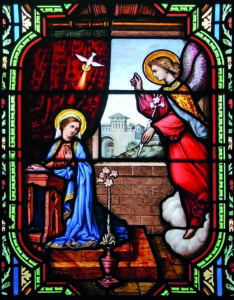
[1]

[2]
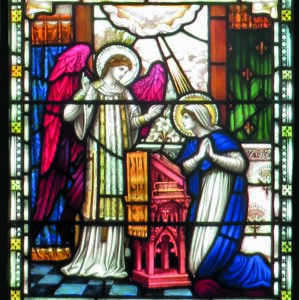
[3]
Joseph is often shown carrying lilies for the same reason. Legend has it that lilies sprang from Joseph’s staff as a sign that God had chosen him to be Mary’s betrothed.
In a similar style are the windows from St Mary of the Angels, Wellington [2], Wanganui Collegiate Chapel, Wanganui [3], and Bibbienna [4], a hill town in Italy. Again, there are lilies. The surroundings are more elaborate than I would expect, as are the kneelers. The beauty of the windows is unquestioned. They are clearly designed to convey the awesome nature of the event.
The simple window from St Saviour’s, Kuranda, Queensland [5], is more like my imaginings. The Angel has caught Mary on the way to fetch water from the well. Similarly, the window from St Mary’s, Banff, Canada [6], shows Mary kneeling, without a kneeler, at her night-time prayers, reading the improbable book in the light of a lamp over her head. The Holy Spirit is symbolised, and the lilies are there, embellishing the simplicity.

[4]
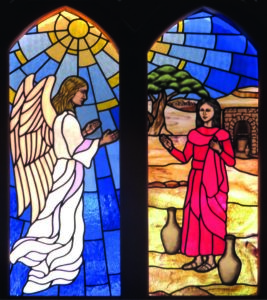
[5]
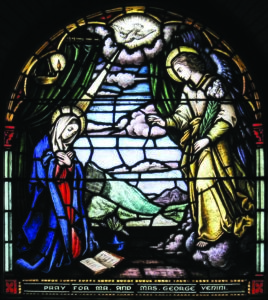
[6]
I can’t go past these four windows for sheer beauty and how they inspire me in their different ways. The one from the Franciscan Friary, Killarney, Ireland [10], is very much in the German style, while the one from St Luke’s, Havelock North [7], contrasts in its beautiful simplicity. The one in St Barnabas, Roseneath, Wellington [8], was designed by Brunton in his own unique style, and the one in St John’s, Trentham, Wellington [9], was designed by my friend Beverley Shore Bennett in her own unique style.

[7]

[8]
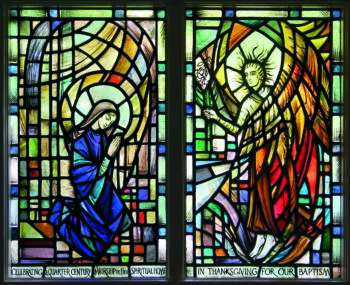
[9]

[10]
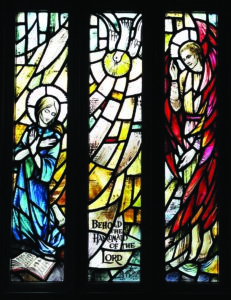
[11]
To me, though, the importance of the feast is that Mary said “yes” to God, and changed history. These last windows depict Mary saying “yes” in their various ways. They are from St Peter’s, Palmerston North [11], St Mary’s, Parnell, Auckland [12], and St John the Baptist, Windsor, England [13].
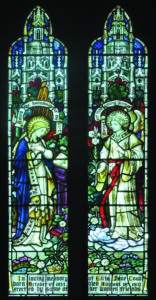
[12]
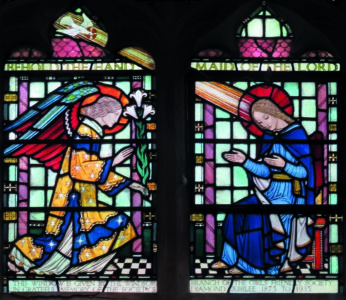
[13]
Have you always said “yes” to God? I haven’t always, to my sorrow. But God has forgiven me, because he loves me. As he loved Mary and chose her to be the mother of his Son. Alleluia!
 Entries(RSS)
Entries(RSS)